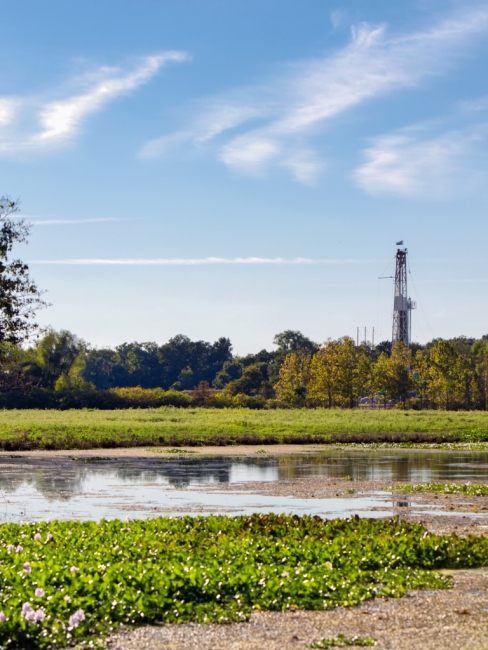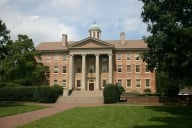You have /5 articles left.
Sign up for a free account or log in.

Drilling rig near a Louisiana bayou
Istockphoto.com/grandriver
We met recently on the Tulane University campus -- a professor of environmental literature from Loyola University and an environmental communication scholar from Tulane -- and we found ourselves talking about what it’s like to teach college right now, when our students often exude a sense of imminent doom. Our students are acutely aware of melting ice caps, our eroding coast and the courage of Greta Thunberg. They see the news of rising sea levels -- North America conspicuously missing from certain projected mappings.
Just last week, anxiety-producing headlines named our city one of several in the country showing the highest levels of “forever chemicals” in drinking water. Our students see clearly how politicians can talk change while doing nothing. Or worse, how leaders can claim greatness even as things get worse.
We work on issues of environmental significance -- the concept of the Anthropocene and the history and politics of Louisiana’s “working coast,” respectively -- so it makes sense for us to live here in New Orleans. But in some ways, residing and teaching here right now can feel fatalistic. Like we have to teach through the doom.
Each day, we have to come to terms with living at the frontier of climate dystopia. The combination of sea-level rise and the state’s coastal subsidence compounds south Louisiana’s disappearance into the sea. It makes sense to talk about the unfolding catastrophe just over the levees, because as one of the world’s harbingers for global warming, New Orleans is a real-time knowledge laboratory. But it’s unsettling when our work amounts to sober assessments and dire predictions that are at odds with the cultural resilience and richness that we also love about New Orleans -- and in many cases, why our students choose Loyola and Tulane in the first place.
We don’t want to be downers, or downers all the time. We want to inspire our students to make meaningful lives that change the world for the better. Ideally, that includes remaking our city for a real possible future.
But what is our role as college instructors, living in this turbulent time that our students feel even more vividly, because they are younger and will inevitably inherit the circumstances that we leave them with?
A recent podcast featured a respected climate warrior, Orrin Pilkey Jr. from Duke University, discussing his new book, Sea Level Rise: A Slow Tsunami on America’s Shores, which asserts that New Orleans is simply doomed. The message was so stark as to be shocking, even for those of us who know on some level that it is true. Sea Level Rise offers a template for loved ones afar to write and urge us here in the danger zone to move to higher ground.
Tactical and Strategic
While we both sometimes worry about being unable to sell our respective midcity homes, we want to think we can make a stand here. New Orleanians are tactical about the future, a mind-set that enables (or rationalizes) us to stay in the city we love despite the nagging indicators of a bleak future. So, while many students from Tulane and Loyola will return to their hometowns safely above the Pleistocene Ridge, a sizable contingent will join our ranks as the proverbial watchers on the wall.
The question we might pose to our students is whether we can be tactical and strategic. Can we leverage our vantage point, here at the edge, to bear witness to our vulnerability and the practices that cause it? We’re thinking of the self-destruction of Louisiana’s coast, which rationalizes deep-sea oil drilling because it funds Master Plan restoration projects, or the wisdom of diverting the Mississippi River into our marshes while our petrochemical industry supplies factories and Midwestern farms with the toxic runoff that pollutes the river, or the illogic that assumes infinite economic growth here -- or anywhere, for that matter -- is possible.
If armed with the ability to critically recognize such systems of contradiction, our students can more nimbly advocate for change because they have not yet succumbed to the fatalism of their elders.
Teaching environmental awareness on the bank of the Mississippi River, we can reflect on its eons of meandering channels and more recent attempts to control its course; our close proximity to the river offers direct lessons in hubris and the ecosystem’s long duration. Nonnative species are not abstract subjects but nearby entities: from the brown anole lizards skittering everywhere to the Triadica sebifera tallow trees erupting from sidewalks, we can see the effects and tensions of global migrations right around us.
And we can translate this attention to the cultural landscape around us, too -- the dense weave of narratives and traditions, threads of violence and resistance. They can be found in the muddy swamps around New Orleans that offered tactical refuge to Native Americans and escaped slaves in “maroon” communities throughout the 18th and 19th centuries. Indeed, we see this historic relationship emblematized by African Americans who hand-stitch elaborate Mardi Gras Indian outfits to pay homage to this deep relationship. Our students, likewise, need only look up or downriver to witness the cultural and economic connections between modern petrochemical industries in Louisiana and the plantation system from which they were born. Today, extractive, dehumanizing practices of these industrial plants that stand on former sugarcane plantations pollute the water and air of the historic black communities that surround them. The environment is a site of politics and racial (in)justice.
At Tulane, students this November entered into wider conversations about the human toll generated by the current Anthropocene epoch in which we now find ourselves through projects and public programming from the recent Mississippi: An Anthropocene River project, which culminated in an international conversation of artists, scholars and scientists in New Orleans. Such initiatives exist to envision new methods of knowledge production from the ground up by listening to affected communities in order to direct future policy trajectories.
At Loyola, environmental studies students recently explored the surrounding wetlands by canoe, experiencing firsthand the swarming vegetal life of the bayous, as well as their crepuscular inhabitants. In a two-week course on nature writing last May, a group of students wrote about pervasive tensions between urban expansion and ecological fragility, tensions that vex the city.
Through such local case studies, we might start to imagine better paths forward.
We offer New Orleans as a site of possibility, a classroom writ large in which we can observe, interpret and disrupt the legacy of extractive thinking so as not to become merely a cautionary tale of ecological insanity. For this rising generation in precarious geographies everywhere, let us model the kinds of practices that can actually save the world in question and not accelerate its demise.








